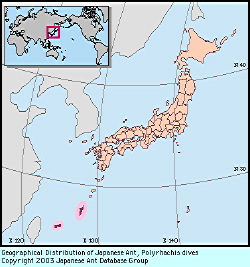
|
species
|
Polyrhachis dives
|
 |
Japanese Name
|
Kuro-toge-ari
|
Original Reference
|
|
Smith, F. (1857) Catalogue of the hymenopterous insects collected at Sarawak, Borneo; Mount Ophir, Malacca; and at Singapore, by A.R. Wallace. Journal of the Proceedings of the Linnean Society of London, Zoology 2: 42-88.
|
Description
|
|
Total length of workers around 5 - 6 mm. Body color black. Mesosoma covered with coarse punctures. Head and gaster with white to whitish yellow pubescence. Dorsal surface of mesosoma arched, dorsolateral margins not carinate. Pronotum with a pair of well-developed teeth directed laterally. Mesonotum without teeth. Propodeum with a pair of well-developed teeth. Petiole with a pair of long lateral spines, which are longer than those of mesosoma, and a pair of small median cornicles.
|
Remarks
|
|
This species is referable to subgenus Myrmhopla. Its nests are found on grasses or trees. They are constructed by the ants using plant leaves and dead twigs, which are woven together with larval silk (Takahashi, 1937; Takamine, 1983). This species is polygynous, including around 50 females in a colony (Yamauchi et al., 1989).
|
|

Distribution
|
|
Nansei Is (Okinawa I. and southwards); Mainland China, Taiwan, Philippines, SE Asia, New Guinea.
|
|
References
|
|
- Takahashi, R. (1937). Biology, extermination and prophylactic measure of Polyrhachis dives. . Rep. Dept. Agr. Gov. Res. Inst. Formosa, (129, 1-12. .
- Takamine, H. (1983). Ecology of a weaver ant, Polyrhachis dives in the Ryukyu Islands: On the nest building by using larvae. . Biol. Mag. Okinawa, 21, 33-39. .
- Yamauchi et al , 1989
- Catalogue of the hymenopterous insects collected at Sarawak, Borneo; Mount Ophir, Malacca; and at Singapore, by A.R. Wallace. Journal of the Proceedings of the Linnean Society of London, Zoology 2: 42-88.
|
Editor
|
|
Original text by Mamoru Terayama and Masao Kubota. English translation by Mamoru Terayama, edited by Robert W. Taylor
|
|